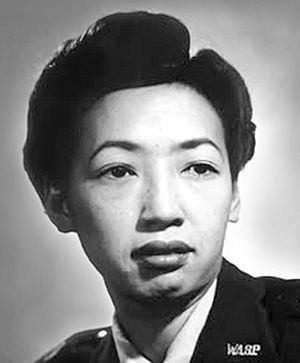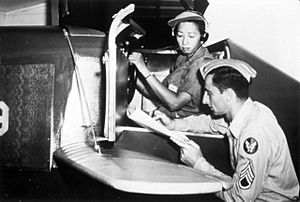Hazel Ying Lee facts for kids
Quick facts for kids
Hazel Ying Lee
|
|
|---|---|
| Chinese: 李月英; Mandarin Pinyin: Lǐ Yuèyīng; Jyutping: lei5 jyut6 jing1 | |

Hazel Ying Lee
|
|
| Born | August 24, 1912 Portland, Oregon, U.S.
|
| Died | November 25, 1944 (aged 32) Great Falls, Montana, U.S.
|
| Cause of death | Plane crash |
| Burial place | River View Cemetery, Portland, Oregon |
| Occupation | Pilot |
| Era | World War II |
| Organization | Women Airforce Service Pilots |
| Spouse(s) | Louie Yim-qun |
| Parents |
|
Hazel Ying Lee (Chinese: 李月英; Mandarin Pinyin: Lǐ Yuèyīng; Jyutping: lei5 jyut6 jing1; August 24, 1912 – November 25, 1944) was an American pilot. She flew for the Women Airforce Service Pilots (WASP) during World War II. She was a brave and determined woman who broke barriers in aviation.
Contents
Early Life and Dream to Fly
Hazel Lee was born in Portland, Oregon, in 1912. Her parents, Yuet Lee and Ssiu Lan Wong, were Chinese immigrants. They owned a Chinese restaurant in Portland. Even though there was a lot of prejudice against Chinese people at the time, Hazel lived a very active life. She enjoyed sports like swimming and handball. She also loved playing cards and learned to drive as a teenager.
After finishing Commerce High School in 1929, Hazel worked as an elevator operator. This was one of the few jobs available to Chinese-American women then.
In 1932, Hazel took her first airplane ride at an air show. She immediately knew she wanted to learn to fly. She joined the Chinese Flying Club of Portland. She took lessons from a famous pilot named Al Greenwood. Her mother was against it, but Hazel felt she "had to fly." Her sister Frances said Hazel loved flying because "It was the thought of doing something she loved. She enjoyed the danger and doing something that was new to Chinese girls."
In October 1932, Hazel Lee became one of the first Chinese-American women to get a pilot's license. Author Judy Yung wrote that these early Chinese-American women pilots "broke the stereotype of the passive Chinese woman." They showed that Chinese-American women could succeed in fields usually dominated by men. While in Portland, Hazel met her future husband, Louie Yim-qun, who was also a pilot.
Flying in China
Before World War II, Hazel Lee went to China in 1933. She wanted to help the Chinese Air Force after Japan invaded Manchuria. Even though pilots were greatly needed, the Republic of China Air Force would not accept women pilots. Because she was a woman, Hazel had to take a desk job. She only flew sometimes for a commercial Chinese company.
Feeling frustrated, Hazel moved to Canton. She spent the next few years flying for a private airline. She was one of the very few women pilots in China at that time. In 1937, Japan invaded China. Hazel stayed in Canton and bravely helped her friends and family find shelter during Japanese air attacks. In 1938, she tried again to join the Air Force as a pilot, but was refused. She then returned to the United States by escaping through Hong Kong. In New York City, she worked buying war materials for China.
WASP Career in World War II
After the Japanese Attack on Pearl Harbor, the United States joined World War II. More pilots were needed for the war effort at home. In 1943, the Women Airforce Service Pilots (WASP) program was created. It was led by famous aviator Jacqueline Cochran.
Experienced women pilots like Hazel Lee were eager to join WASP. They went to Avenger Field in Sweetwater, Texas, for tough six-month training. Hazel was accepted into the 4th class, 43 W 4. She became the first Chinese-American woman to fly for the United States military. During her training, Hazel once fell out of a plane when her instructor did an unexpected loop. Her seat belt wasn't fastened, but she saved herself using her parachute. She landed safely in a field and walked back to the base.
WASP pilots were considered civilians, not military personnel. They were paid through civil service. They did not get military benefits. If a WASP pilot died, they were not allowed military funerals. WASPs often got the hardest missions, like flying in open cockpit planes in winter. At first, commanders didn't want women delivering planes. This only changed after an order from the head of the Air Transport Command.
After graduation, Hazel was sent to the Third Ferrying Group in Romulus, Michigan. Their job was very important for the war. They delivered new planes from factories to places where they would be shipped overseas. These planes went to the European and Pacific War fronts. Hazel wrote to her sister that Romulus was a "7-day workweek, with little time off."
Hazel quickly became a leader among the WASPs. A fellow pilot said Hazel's attitude was: "I'll take and deliver anything." Her friends described her as "calm and fearless," even during emergency landings. Once, she made an emergency landing in a wheat field in Kansas. A farmer, thinking the Japanese had invaded, chased her with a pitchfork! Hazel calmly told him who she was and made him stop. She was known for her humor and being mischievous. She often used lipstick to draw Chinese characters on the tails of planes.
Hazel was also a great cook. She could always find a Chinese restaurant, even in small towns. She would often supervise the menu or cook the food herself. Fellow WASP pilot Sylvia Dahmes Clayton said, "Hazel provided me with an opportunity to learn about a different culture... She expanded my world and my outlook on life."
In September 1944, Hazel went to Pursuit School in Brownsville, Texas. She trained to fly faster, high-powered fighter planes. These included the P-63 Kingcobra, P-51 Mustang, and P-39 Airacobra. Hazel loved the Mustang. She was among the first women to pilot fighter aircraft for the United States military.
Tragic End and Lasting Legacy
On November 10, 1944, Hazel was ordered to fly a P-63 Kingcobra from Niagara Falls, New York, to Great Falls, Montana. During the war, Hazel and other Pursuit pilots delivered over 5,000 fighters to Great Falls. From there, male pilots flew the planes to Alaska. Soviet pilots then took them to help fight the Nazis under the Lend-Lease program.
Bad weather delayed Hazel's mission in Fargo, North Dakota. On November 23, the weather cleared, and she left Fargo. Later that day, Hazel was cleared to land in Great Falls. Many P-63s were approaching the airport at the same time. There was confusion in the control tower. Hazel's plane collided with another P-63. Both planes caught fire. Hazel was pulled from her burning plane but had severe burns. Two days later, on November 25, 1944, she died from her injuries.
Just three days after Hazel's death, her family received another telegram. It said that Hazel's brother, Victor, who was serving in the U.S. Tank Corps, had been killed in France. As the family prepared to bury Hazel and Victor, they faced another challenge. The cemetery refused to bury them in their chosen spot. They said their policy did not allow Asians to be buried in the "White section." After a long fight, the Lee family won. Hazel Lee was buried in a non-military funeral next to her brother at River View Cemetery. Their graves overlook the Willamette River.
For over 30 years after the war, WASP members fought for military status. In March 1977, their efforts were finally recognized. Public Law 95-202 granted military status to the Women Airforce Service Pilots. Thirty-eight WASP pilots died while serving during World War II. Hazel Lee was the last one to die during the program. In 2010, she and all other WASP pilots received the Congressional Gold Medal.
In 2004, Hazel Ying Lee was honored in Oregon's Aviation Hall of Honor. This group recognizes Oregonians who made important contributions to aviation. Hazel Lee is remembered for her bravery, her service, and her fight for equality and inclusion. In 2010, PBS aired a documentary about her called A Brief Flight: Hazel Ying Lee and The Women Who Flew Pursuit.
See also
 In Spanish: Hazel Ying Lee para niños
In Spanish: Hazel Ying Lee para niños



